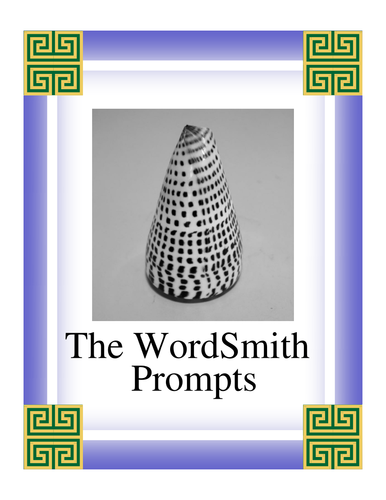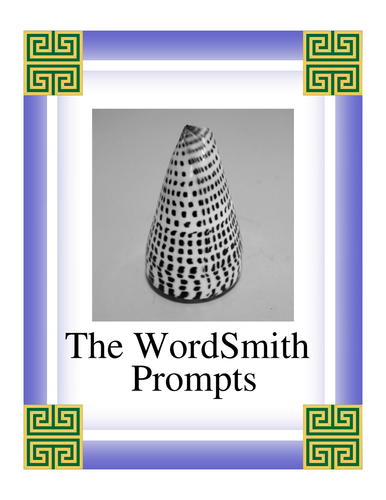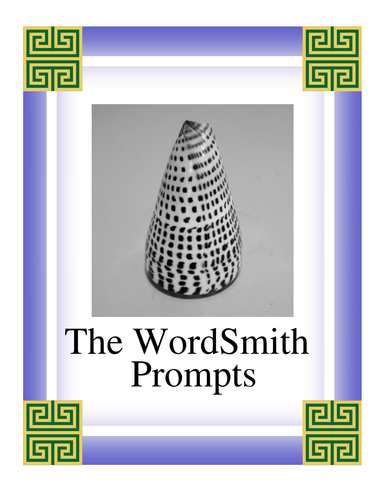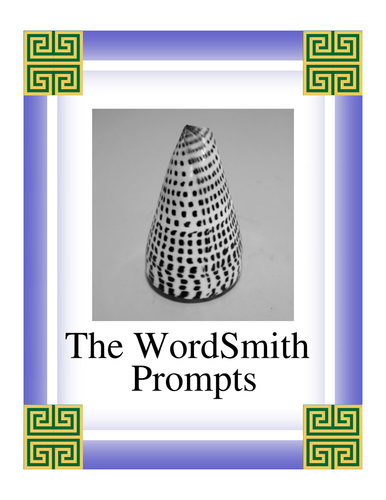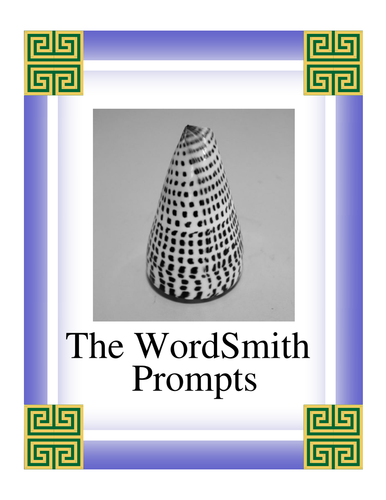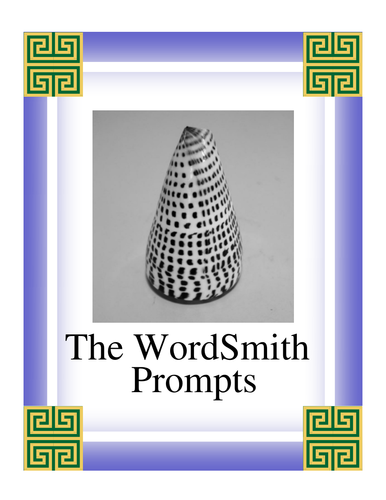
407Uploads
74k+Views
8k+Downloads
All resources

The WordSmith Literacy Units for KS2 (2)
This is the second of seventeen stand-alone literacy units built around the highly acclaimed animal adventure story ‘Paka Mdogo – Little Cat’. Each unit is based on a single chapter from the book, and includes the text itself…so over the course of a term children will be able to enjoy the whole story as a piece of fiction ‘with excellent literary credentials’ (Library Thing review) – appropriate to Years 4 to 6 but offering engagement, suspense, humour and challenge to readers of all ages. The ‘Paka Mdogo’ series has been described as ‘Books for Thinking Children’ but it also has a strong appeal to thinking adults since it addresses, in a wholly refreshing way, a large number of issues important to us all.
Each unit includes a summary of ‘the story so far’ sufficient to allow a full understanding of events within the chapter, without prior reading. Teachers can therefore, if they wish, use the units selectively, making use of the ongoing summaries to bridge any narrative gaps and keep the class eager to know what happens next.
The units are aligned to the general objectives of the National Curriculum, and teachers making use of them can be assured that their students will be exposed to a wide range of reading, writing, speaking and listening tasks – and thinking activities – designed to promote those objectives with minimal tribulation and maximum delight.
‘Thinking activities’? Imaginative prompts that challenge students to read into, and often beyond, the written text.
Study tasks include the full range of question types (single-answer, multiple choice, closed, open, evaluative) and a variety of writing and speaking activities (personal, narrative, expository, analytical, persuasive, interactive).
Questions on the illustrations are included to help enhance students’ visual, as well as textual, literacy.
Some practicalities:
• The units are in printable pdf format, and can be used either on-screen or in photocopy from the master file.
• Each page of the unit carries one page of text from the chapter, a study task based on it, and working spaces. Additional, more broadly-based study tasks span the whole chapter.
• Students given print copies can use either the working spaces or a separate workbook. Those working on-screen will be able to add their responses by means of a text insertion tool or the comments/sticky notes function, depending on the program used to open the pdf file – or, again, in a separate workbook.
• Two editions of the unit – Teaching and Student – are included in the resource, together with a copy of the Teacher Notes, a map of the fictional Baragandiri National Park and a one-page summary of the whole story.

The WordSmith Literacy Units for KS2 (1)
This is the first of seventeen stand-alone literacy units built around the highly acclaimed animal adventure story ‘Paka Mdogo – Little Cat’. Each unit is based on a single chapter from the book, and includes the text itself…so over the course of a term children will be able to enjoy the whole story as a piece of fiction ‘with excellent literary credentials’ (Library Thing review) – appropriate to Years 4 to 6 but offering engagement, suspense, humour and challenge to readers of all ages. The ‘Paka Mdogo’ series has been described as ‘Books for Thinking Children’ but it also has a strong appeal to thinking adults since it addresses, in a wholly refreshing way, a large number of issues important to us all.
Each unit includes a summary of ‘the story so far’ sufficient to allow a full understanding of events within the chapter, without prior reading. Teachers can therefore, if they wish, use the units selectively, making use of the ongoing summaries to bridge any narrative gaps and keep the class eager to know what happens next.
The units are aligned to the general objectives of the National Curriculum, and teachers making use of them can be assured that their students will be exposed to a wide range of reading, writing, speaking and listening tasks – and thinking activities – designed to promote those objectives with minimal tribulation and maximum delight.
‘Thinking activities’? Imaginative prompts that challenge students to read into, and often beyond, the written text.
Study tasks include the full range of question types (single-answer, multiple choice, closed, open, evaluative) and a variety of writing and speaking activities (personal, narrative, expository, analytical, persuasive, interactive).
Questions on the illustrations are included to help enhance students’ visual, as well as textual, literacy.
Some practicalities:
• The units are in printable pdf format, and can be used either on-screen or in photocopy from the master file.
• Each page of the unit carries one page of text from the chapter, a study task based on it, and working spaces. Additional, more broadly-based study tasks span the whole chapter.
• Students given print copies can use either the working spaces or a separate workbook. Those working on-screen will be able to add their responses by means of a text insertion tool or the comments/sticky notes function, depending on the program used to open the pdf file – or, again, in a separate workbook.
• Two editions of the unit – Teaching and Student – are included in the resource, together with a copy of the Teacher Notes, a map of the fictional Baragandiri National Park and a one-page summary of the whole story.

The WordSmith Literacy Units for KS2 (4)
This is the fourth of seventeen stand-alone literacy units built around the highly acclaimed animal adventure story ‘Paka Mdogo – Little Cat’. Each unit is based on a single chapter from the book, and includes the text itself…so over the course of a term children will be able to enjoy the whole story as a piece of fiction ‘with excellent literary credentials’ (Library Thing review) – appropriate to Years 4 to 6 but offering engagement, suspense, humour and challenge to readers of all ages. The ‘Paka Mdogo’ series has been described as ‘Books for Thinking Children’ but it also has a strong appeal to thinking adults since it addresses, in a wholly refreshing way, a large number of issues important to us all.
Each unit includes a summary of ‘the story so far’ sufficient to allow a full understanding of events within the chapter, without prior reading. Teachers can therefore, if they wish, use the units selectively, making use of the ongoing summaries to bridge any narrative gaps and keep the class eager to know what happens next.
The units are aligned to the general objectives of the National Curriculum, and teachers making use of them can be assured that their students will be exposed to a wide range of reading, writing, speaking and listening tasks – and thinking activities – designed to promote those objectives with minimal tribulation and maximum delight.
‘Thinking activities’? Imaginative prompts that challenge students to read into, and often beyond, the written text.
Study tasks include the full range of question types (single-answer, multiple choice, closed, open, evaluative) and a variety of writing and speaking activities (personal, narrative, expository, analytical, persuasive, interactive).
Questions on the illustrations are included to help enhance students’ visual, as well as textual, literacy.
Some practicalities:
• The units are in printable pdf format, and can be used either on-screen or in photocopy from the master file.
• Each page of the unit carries one page of text from the chapter, a study task based on it, and working spaces. Additional, more broadly-based study tasks span the whole chapter.
• Students given print copies can use either the working spaces or a separate workbook. Those working on-screen will be able to add their responses by means of a text insertion tool or the comments/sticky notes function, depending on the program used to open the pdf file – or, again, in a separate workbook.
• Two editions of the unit – Teaching and Student – are included in the resource, together with a copy of the Teacher Notes, a map of the fictional Baragandiri National Park and a one-page summary of the whole story.

The WordSmith Literacy Units for KS2 (3)
This is the third of seventeen stand-alone literacy units built around the highly acclaimed animal adventure story ‘Paka Mdogo – Little Cat’. Each unit is based on a single chapter from the book, and includes the text itself…so over the course of a term children will be able to enjoy the whole story as a piece of fiction ‘with excellent literary credentials’ (Library Thing review) – appropriate to Years 4 to 6 but offering engagement, suspense, humour and challenge to readers of all ages. The ‘Paka Mdogo’ series has been described as ‘Books for Thinking Children’ but it also has a strong appeal to thinking adults since it addresses, in a wholly refreshing way, a large number of issues important to us all.
Each unit includes a summary of ‘the story so far’ sufficient to allow a full understanding of events within the chapter, without prior reading. Teachers can therefore, if they wish, use the units selectively, making use of the ongoing summaries to bridge any narrative gaps and keep the class eager to know what happens next.
The units are aligned to the general objectives of the National Curriculum, and teachers making use of them can be assured that their students will be exposed to a wide range of reading, writing, speaking and listening tasks – and thinking activities – designed to promote those objectives with minimal tribulation and maximum delight.
‘Thinking activities’? Imaginative prompts that challenge students to read into, and often beyond, the written text.
Study tasks include the full range of question types (single-answer, multiple choice, closed, open, evaluative) and a variety of writing and speaking activities (personal, narrative, expository, analytical, persuasive, interactive).
Questions on the illustrations are included to help enhance students’ visual, as well as textual, literacy.
Some practicalities:
• The units are in printable pdf format, and can be used either on-screen or in photocopy from the master file.
• Each page of the unit carries one page of text from the chapter, a study task based on it, and working spaces. Additional, more broadly-based study tasks span the whole chapter.
• Students given print copies can use either the working spaces or a separate workbook. Those working on-screen will be able to add their responses by means of a text insertion tool or the comments/sticky notes function, depending on the program used to open the pdf file – or, again, in a separate workbook.
• Two editions of the unit – Teaching and Student – are included in the resource, together with a copy of the Teacher Notes, a map of the fictional Baragandiri National Park and a one-page summary of the whole story.

The WordSmith Literacy Units for KS2 (9)
This is the ninth of seventeen stand-alone literacy units built around the highly acclaimed animal adventure story ‘Paka Mdogo – Little Cat’. Each unit is based on a single chapter from the book, and includes the text itself…so over the course of a term children will be able to enjoy the whole story as a piece of fiction ‘with excellent literary credentials’ (Library Thing review) – appropriate to Years 4 to 6 but offering engagement, suspense, humour and challenge to readers of all ages. The ‘Paka Mdogo’ series has been described as ‘Books for Thinking Children’ but it also has a strong appeal to thinking adults since it addresses, in a wholly refreshing way, a large number of issues important to us all.
Each unit includes a summary of ‘the story so far’ sufficient to allow a full understanding of events within the chapter, without prior reading. Teachers can therefore, if they wish, use the units selectively, making use of the ongoing summaries to bridge any narrative gaps and keep the class eager to know what happens next.
The units are aligned to the general objectives of the National Curriculum, and teachers making use of them can be assured that their students will be exposed to a wide range of reading, writing, speaking and listening tasks – and thinking activities – designed to promote those objectives with minimal tribulation and maximum delight.
‘Thinking activities’? Imaginative prompts that challenge students to read into, and often beyond, the written text.
Study tasks include the full range of question types (single-answer, multiple choice, closed, open, evaluative) and a variety of writing and speaking activities (personal, narrative, expository, analytical, persuasive, interactive).
Questions on the illustrations are included to help enhance students’ visual, as well as textual, literacy.
Some practicalities:
• The units are in printable pdf format, and can be used either on-screen or in photocopy from the master file.
• Each page of the unit carries one page of text from the chapter, a study task based on it, and working spaces. Additional, more broadly-based study tasks span the whole chapter.
• Students given print copies can use either the working spaces or a separate workbook. Those working on-screen will be able to add their responses by means of a text insertion tool or the comments/sticky notes function, depending on the program used to open the pdf file – or, again, in a separate workbook.
• Two editions of the unit – Teaching and Student – are included in the resource, together with a copy of the Teacher Notes, a map of the fictional Baragandiri National Park and a one-page summary of the whole story.

The WordSmith Literacy Units for KS2 (13)
This is the thirteenth of seventeen stand-alone literacy units built around the highly acclaimed animal adventure story ‘Paka Mdogo – Little Cat’. Each unit is based on a single chapter from the book, and includes the text itself…so over the course of a term children will be able to enjoy the whole story as a piece of fiction ‘with excellent literary credentials’ (Library Thing review) – appropriate to Years 4 to 6 but offering engagement, suspense, humour and challenge to readers of all ages. The ‘Paka Mdogo’ series has been described as ‘Books for Thinking Children’ but it also has a strong appeal to thinking adults since it addresses, in a wholly refreshing way, a large number of issues important to us all.
Each unit includes a summary of ‘the story so far’ sufficient to allow a full understanding of events within the chapter, without prior reading. Teachers can therefore, if they wish, use the units selectively, making use of the ongoing summaries to bridge any narrative gaps and keep the class eager to know what happens next.
The units are aligned to the general objectives of the National Curriculum, and teachers making use of them can be assured that their students will be exposed to a wide range of reading, writing, speaking and listening tasks – and thinking activities – designed to promote those objectives with minimal tribulation and maximum delight.
‘Thinking activities’? Imaginative prompts that challenge students to read into, and often beyond, the written text.
Study tasks include the full range of question types (single-answer, multiple choice, closed, open, evaluative) and a variety of writing and speaking activities (personal, narrative, expository, analytical, persuasive, interactive).
Questions on the illustrations are included to help enhance students’ visual, as well as textual, literacy.
Some practicalities:
• The units are in printable pdf format, and can be used either on-screen or in photocopy from the master file.
• Each page of the unit carries one page of text from the chapter, a study task based on it, and working spaces. Additional, more broadly-based study tasks span the whole chapter.
• Students given print copies can use either the working spaces or a separate workbook. Those working on-screen will be able to add their responses by means of a text insertion tool or the comments/sticky notes function, depending on the program used to open the pdf file – or, again, in a separate workbook.
• Two editions of the unit – Teaching and Student – are included in the resource, together with a copy of the Teacher Notes, a map of the fictional Baragandiri National Park and a one-page summary of the whole story.

The WordSmith Literacy Units for KS2 (15)
This is the fifteenth of seventeen stand-alone literacy units built around the highly acclaimed animal adventure story ‘Paka Mdogo – Little Cat’. Each unit is based on a single chapter from the book, and includes the text itself…so over the course of a term children will be able to enjoy the whole story as a piece of fiction ‘with excellent literary credentials’ (Library Thing review) – appropriate to Years 4 to 6 but offering engagement, suspense, humour and challenge to readers of all ages. The ‘Paka Mdogo’ series has been described as ‘Books for Thinking Children’ but it also has a strong appeal to thinking adults since it addresses, in a wholly refreshing way, a large number of issues important to us all.
Each unit includes a summary of ‘the story so far’ sufficient to allow a full understanding of events within the chapter, without prior reading. Teachers can therefore, if they wish, use the units selectively, making use of the ongoing summaries to bridge any narrative gaps and keep the class eager to know what happens next.
The units are aligned to the general objectives of the National Curriculum, and teachers making use of them can be assured that their students will be exposed to a wide range of reading, writing, speaking and listening tasks – and thinking activities – designed to promote those objectives with minimal tribulation and maximum delight.
‘Thinking activities’? Imaginative prompts that challenge students to read into, and often beyond, the written text.
Study tasks include the full range of question types (single-answer, multiple choice, closed, open, evaluative) and a variety of writing and speaking activities (personal, narrative, expository, analytical, persuasive, interactive).
Questions on the illustrations are included to help enhance students’ visual, as well as textual, literacy.
Some practicalities:
• The units are in printable pdf format, and can be used either on-screen or in photocopy from the master file.
• Each page of the unit carries one page of text from the chapter, a study task based on it, and working spaces. Additional, more broadly-based study tasks span the whole chapter.
• Students given print copies can use either the working spaces or a separate workbook. Those working on-screen will be able to add their responses by means of a text insertion tool or the comments/sticky notes function, depending on the program used to open the pdf file – or, again, in a separate workbook.
• Two editions of the unit – Teaching and Student – are included in the resource, together with a copy of the Teacher Notes, a map of the fictional Baragandiri National Park and a one-page summary of the whole story.

The WordSmith Literacy Units for KS2 (14)
This is the fourteenth of seventeen stand-alone literacy units built around the highly acclaimed animal adventure story ‘Paka Mdogo – Little Cat’. Each unit is based on a single chapter from the book, and includes the text itself…so over the course of a term children will be able to enjoy the whole story as a piece of fiction ‘with excellent literary credentials’ (Library Thing review) – appropriate to Years 4 to 6 but offering engagement, suspense, humour and challenge to readers of all ages. The ‘Paka Mdogo’ series has been described as ‘Books for Thinking Children’ but it also has a strong appeal to thinking adults since it addresses, in a wholly refreshing way, a large number of issues important to us all.
Each unit includes a summary of ‘the story so far’ sufficient to allow a full understanding of events within the chapter, without prior reading. Teachers can therefore, if they wish, use the units selectively, making use of the ongoing summaries to bridge any narrative gaps and keep the class eager to know what happens next.
The units are aligned to the general objectives of the National Curriculum, and teachers making use of them can be assured that their students will be exposed to a wide range of reading, writing, speaking and listening tasks – and thinking activities – designed to promote those objectives with minimal tribulation and maximum delight.
‘Thinking activities’? Imaginative prompts that challenge students to read into, and often beyond, the written text.
Study tasks include the full range of question types (single-answer, multiple choice, closed, open, evaluative) and a variety of writing and speaking activities (personal, narrative, expository, analytical, persuasive, interactive).
Questions on the illustrations are included to help enhance students’ visual, as well as textual, literacy.
Some practicalities:
• The units are in printable pdf format, and can be used either on-screen or in photocopy from the master file.
• Each page of the unit carries one page of text from the chapter, a study task based on it, and working spaces. Additional, more broadly-based study tasks span the whole chapter.
• Students given print copies can use either the working spaces or a separate workbook. Those working on-screen will be able to add their responses by means of a text insertion tool or the comments/sticky notes function, depending on the program used to open the pdf file – or, again, in a separate workbook.
• Two editions of the unit – Teaching and Student – are included in the resource, together with a copy of the Teacher Notes, a map of the fictional Baragandiri National Park and a one-page summary of the whole story.

The WordSmith Literacy Units for KS2 (17)
This is the last of seventeen stand-alone literacy units built around the highly acclaimed animal adventure story ‘Paka Mdogo – Little Cat’. Each unit is based on a single chapter from the book, and includes the text itself…so over the course of a term children will be able to enjoy the whole story as a piece of fiction ‘with excellent literary credentials’ (Library Thing review) – appropriate to Years 4 to 6 but offering engagement, suspense, humour and challenge to readers of all ages. The ‘Paka Mdogo’ series has been described as ‘Books for Thinking Children’ but it also has a strong appeal to thinking adults since it addresses, in a wholly refreshing way, a large number of issues important to us all.
Each unit includes a summary of ‘the story so far’ sufficient to allow a full understanding of events within the chapter, without prior reading. Teachers can therefore, if they wish, use the units selectively, making use of the ongoing summaries to bridge any narrative gaps and keep the class eager to know what happens next.
The units are aligned to the general objectives of the National Curriculum, and teachers making use of them can be assured that their students will be exposed to a wide range of reading, writing, speaking and listening tasks – and thinking activities – designed to promote those objectives with minimal tribulation and maximum delight.
‘Thinking activities’? Imaginative prompts that challenge students to read into, and often beyond, the written text.
Study tasks include the full range of question types (single-answer, multiple choice, closed, open, evaluative) and a variety of writing and speaking activities (personal, narrative, expository, analytical, persuasive, interactive).
Questions on the illustrations are included to help enhance students’ visual, as well as textual, literacy.
Some practicalities:
• The units are in printable pdf format, and can be used either on-screen or in photocopy from the master file.
• Each page of the unit carries one page of text from the chapter, a study task based on it, and working spaces. Additional, more broadly-based study tasks span the whole chapter.
• Students given print copies can use either the working spaces or a separate workbook. Those working on-screen will be able to add their responses by means of a text insertion tool or the comments/sticky notes function, depending on the program used to open the pdf file – or, again, in a separate workbook.
• Two editions of the unit – Teaching and Student – are included in the resource, together with a copy of the Teacher Notes, a map of the fictional Baragandiri National Park and a one-page summary of the whole story.

The Handmaid's Tale: Study Prompts
This 14-page resource is a set of short writing tasks, and formal essay questions in the style of A Level, AP and IB examinations. The initial tasks focus student attention on significant aspects of each chapter and build up a full understanding of what Margaret Atwood is trying to achieve, how she is trying to achieve it, and how successful she has been. The chapter-based questions can, additionally, be used as a basis for class discussion, and the essay topics as an invaluable tool for pre-examination revision and rehearsal. At a time-saving level, teachers will be relieved of the need to develop their own units of study for the work, and to seek out relevant questions from past examinations. ‘These prompts are a terrific tool for generating class discussions, creating short answer exams, or longer essay assignments. I have purchased a number of them and am impressed with each one’ (from the LitWorks.com Commendations page).

The Great Gatsby: Study Prompts
This 13-page resource is a set of short writing tasks, and formal essay questions in the style of A Level, AP and IB examinations. The initial tasks focus student attention on significant aspects of each chapter and build up a full understanding of what Fitzgerald is trying to achieve, how he is trying to achieve it, and how successful he has been. The chapter-based questions can, additionally, be used as a basis for class discussion, and the essay topics as an invaluable tool for pre-examination revision and rehearsal. At a time-saving level, teachers will be relieved of the need to develop their own units of study for the work, and to seek out relevant questions from past examinations. ‘These prompts are a terrific tool for generating class discussions, creating short answer exams, or longer essay assignments. I have purchased a number of them and am impressed with each one’ (from the LitWorks.com Commendations page).

Pride and Prejudice: Study Prompts
This 16-page resource is a set of short writing tasks, and formal essay questions in the style of A Level, AP and IB examinations. The initial tasks focus student attention on significant aspects of each chapter and build up a full understanding of what Jane Austen is trying to achieve, how she is trying to achieve it, and how successful she has been. The chapter-based questions can, additionally, be used as a basis for class discussion, and the essay topics as an invaluable tool for pre-examination revision and rehearsal. At a time-saving level, teachers will be relieved of the need to develop their own units of study for the work, and to seek out relevant questions from past examinations. ‘These prompts are a terrific tool for generating class discussions, creating short answer exams, or longer essay assignments. I have purchased a number of them and am impressed with each one’ (from the LitWorks.com Commendations page).

A View from the Bridge: Study Prompts
This 25-page resource is a set of short writing tasks, and formal essay questions in the style of A Level, AP and IB examinations. The initial tasks focus student attention on significant aspects of the text, and build up a full understanding of what Miller is trying to achieve, how he is trying to achieve it, and how successful he has been. The text-based questions can, additionally, be used as a basis for class discussion, and the essay topics as an invaluable tool for pre-examination revision and rehearsal. At a time-saving level, teachers will be relieved of the need to develop their own units of study for the play, and to seek out relevant questions from past examinations. ‘These prompts are a terrific tool for generating class discussions, creating short answer exams, or longer essay assignments. I have purchased a number of them and am impressed with each one’ (from the LitWorks.com Commendations page).

I Know Why the Caged Bird Sings: Study Prompts
This 13-page resource is a set of short writing tasks, and formal essay questions in the style of A Level, AP and IB examinations. The initial tasks focus student attention on significant aspects of each chapter, and build up a full understanding of what Maya Angelou is trying to achieve, how she is trying to achieve it, and how successful she has been. The chapter-based questions can, additionally, be used as a basis for class discussion, and the essay topics as an invaluable tool for pre-examination revision and rehearsal. At a time-saving level, teachers will be relieved of the need to develop their own units of study for the work, and to seek out relevant questions from past examinations. ‘These prompts are a terrific tool for generating class discussions, creating short answer exams, or longer essay assignments. I have purchased a number of them and am impressed with each one’ (from the LitWorks.com Commendations page).

A Thousand Splendid Suns: Study Prompts
This 18-page resource is a set of short writing tasks, and formal essay questions in the style of A Level, AP and IB examinations. The initial tasks focus student attention on significant aspects of each chapter, and build up a full understanding of what Khaled Husseini is trying to achieve, how he is trying to achieve it, and how successful he has been. The chapter-based questions can, additionally, be used as a basis for class discussion, and the essay topics as an invaluable tool for pre-examination revision and rehearsal. At a time-saving level, teachers will be relieved of the need to develop their own units of study for the work, and to seek out relevant questions from past examinations. ‘These prompts are a terrific tool for generating class discussions, creating short answer exams, or longer essay assignments. I have purchased a number of them and am impressed with each one’ (from the LitWorks.com Commendations page).

Death of a Salesman: Study Prompts
This 17-page resource is a set of short writing tasks, and formal essay questions in the style of A Level, AP and IB examinations. The initial tasks focus student attention on significant aspects of each scene, and build up a full understanding of what Arthur Miller is trying to achieve, how he is trying to achieve it, and how successful he has been. The scene-based questions can, additionally, be used as a basis for class discussion, and the essay topics as an invaluable tool for pre-examination revision and rehearsal. At a time-saving level, teachers will be relieved of the need to develop their own units of study for the work, and to seek out relevant questions from past examinations. ‘These prompts are a terrific tool for generating class discussions, creating short answer exams, or longer essay assignments. I have purchased a number of them and am impressed with each one’ (from the LitWorks.com Commendations page).

Animal Farm: Study Prompts
This 23-page resource is a set of short writing tasks, and formal essay questions in the style of A Level, AP and IB examinations. The initial tasks focus student attention on significant aspects of each chapter, and build up a full understanding of what Orwell is trying to achieve, how he is trying to achieve it, and how successful he has been. The chapter-based questions can, additionally, be used as a basis for class discussion, and the essay topics as an invaluable tool for pre-examination revision and rehearsal. At a time-saving level, teachers will be relieved of the need to develop their own units of study for the novel, and to seek out relevant questions from past examinations. ‘These prompts are a terrific tool for generating class discussions, creating short answer exams, or longer essay assignments. I have purchased a number of them and am impressed with each one’ (from the LitWorks.com Commendations page).

Atonement: Study Prompts
This 16-page resource is a set of short writing tasks, and formal essay questions in the style of A Level, AP and IB examinations. The initial tasks focus student attention on significant aspects of each chapter, and build up a full understanding of what Ian McEwan is trying to achieve, how he is trying to achieve it, and how successful he has been. The chapter-based questions can, additionally, be used as a basis for class discussion, and the essay topics as an invaluable tool for pre-examination revision and rehearsal. At a time-saving level, teachers will be relieved of the need to develop their own units of study for the work, and to seek out relevant questions from past examinations. ‘These prompts are a terrific tool for generating class discussions, creating short answer exams, or longer essay assignments. I have purchased a number of them and am impressed with each one’ (from the LitWorks.com Commendations page).

Never Let Me Go: Study Prompts
This 18-page resource is a set of short writing tasks, and formal essay questions in the style of A Level, AP and IB examinations. The initial tasks focus student attention on significant aspects of each chapter and build up a full understanding of what Kazuo Ishiguro is trying to achieve, how he is trying to achieve it, and how successful he has been. The chapter-based questions can, additionally, be used as a basis for class discussion, and the essay topics as an invaluable tool for pre-examination revision and rehearsal. At a time-saving level, teachers will be relieved of the need to develop their own units of study for the work, and to seek out relevant questions from past examinations. ‘These prompts are a terrific tool for generating class discussions, creating short answer exams, or longer essay assignments. I have purchased a number of them and am impressed with each one’ (from the LitWorks.com Commendations page).

The Curious Incident of the Dog in the Night-Time: Study Prompts
This 15-page resource is a set of short writing tasks, and formal essay questions in the style of A Level, AP and IB examinations. The initial tasks focus student attention on significant aspects of each chapter and build up a full understanding of what Mark Haddon is trying to achieve, how he is trying to achieve it, and how successful he has been. The chapter-based questions can, additionally, be used as a basis for class discussion, and the essay topics as an invaluable tool for pre-examination revision and rehearsal. At a time-saving level, teachers will be relieved of the need to develop their own units of study for the work, and to seek out relevant questions from past examinations. ‘These prompts are a terrific tool for generating class discussions, creating short answer exams, or longer essay assignments. I have purchased a number of them and am impressed with each one’ (from the LitWorks.com Commendations page).










